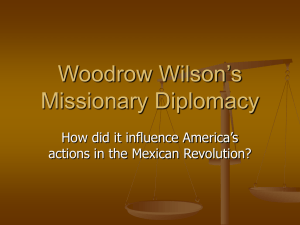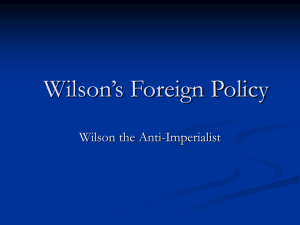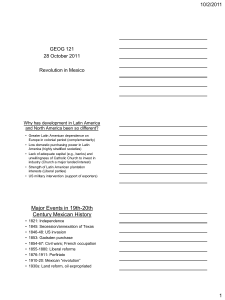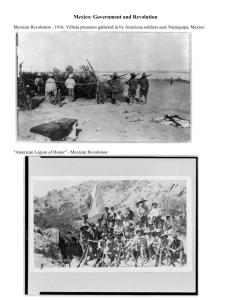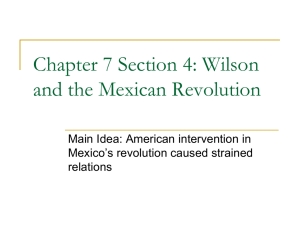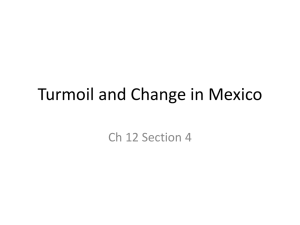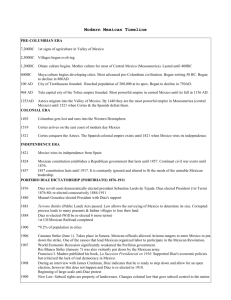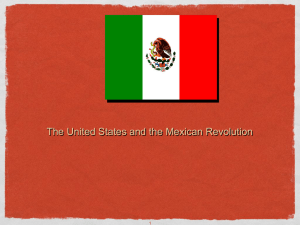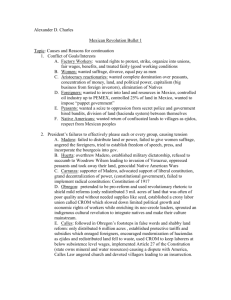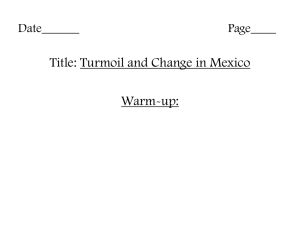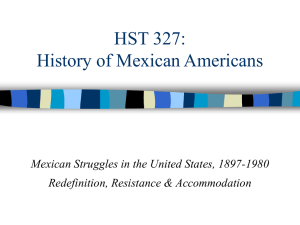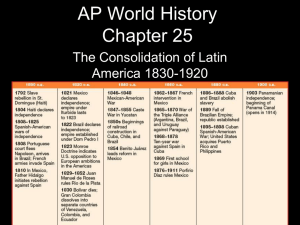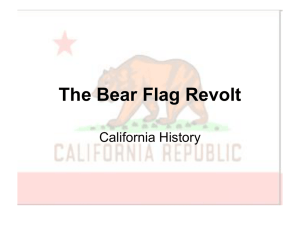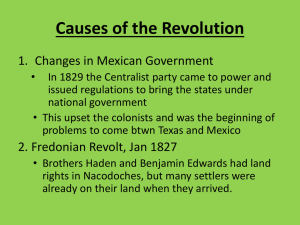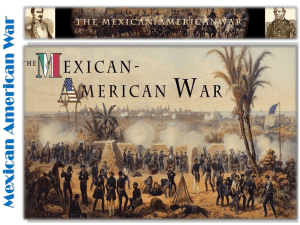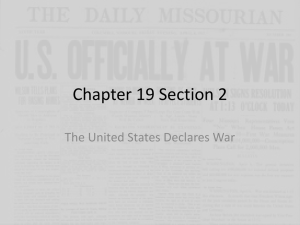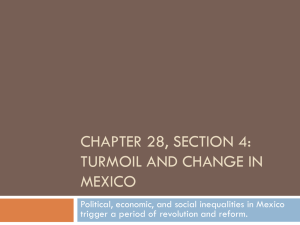The Role of Foreign Powers in the Mexican Revolution 1910-1940
advertisement
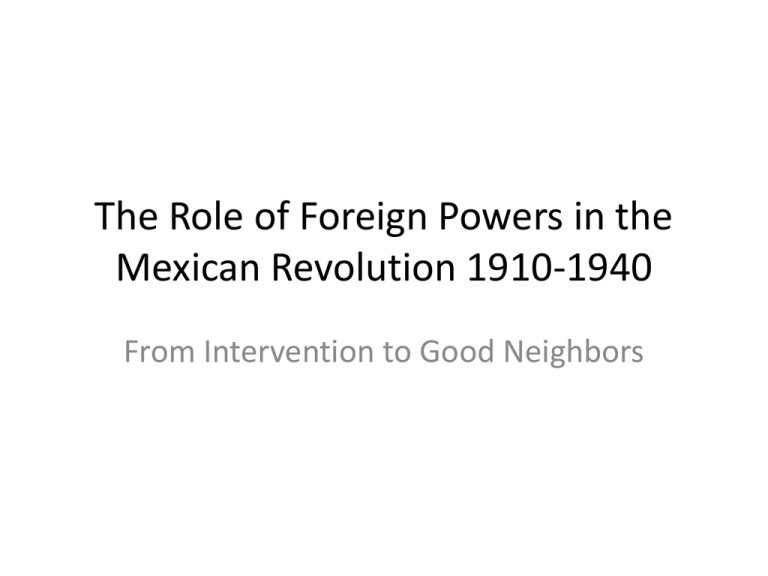
The Role of Foreign Powers in the Mexican Revolution 1910-1940 From Intervention to Good Neighbors Overview • Extent of U.S. and European economic influence before 1910 • U.S. Diplomatic reaction to the Mexican Revolution • Latin American and U.S. Interventions • U.S. Response to Villa’s raid • Effects of the Zimmerman note on the Mexican Revolution • Causes of post constitutional economic tensions What was the extent of U.S. and European economic influence before 1910? • Porifirio Diaz wanted Mexico to modernize and become a peer in the modern world. – Long standing government would provide the stability required to modernize – Encouraging foreign investment would speed up the process of economic and industrial modernization Foreign Investment • Railroads – Railroads are the basis for modernization and industrialization, first lines connected Mexico City to El Paso ,Texas. – By the end of the 1880’s lines connected Atlantic and Pacific Ports mostly controlled by foreign • British and Americans – Vast majority of these investments were held by British and American interests – Some contracts with Japan for agriculture and ceramic manufacturing What was the U.S. Diplomatic reaction to the Mexican Revolution 1910-1913? • President Taft – Insisted that U.S. economic interests should be protected • President Wilson – Recalled Ambassador Wilson – Said Huerta’s government were butchers • Ambassador Wilson – Steeped in the Big Stick and Dollar Diplomacy – Did not support Madero or Mexico – Influential during the Ten Tragic Days What were the U.S. Interventions in Latin America 1911-1914? • Huerta’s Coup – Varied reactions among Latin American countries – US did not support Huerta’s government – Resented European influence in Mexico • The Tampico Affair and Veracruz Occupation – Insignificant incident became motivation for US intervention – Wilson ordered US Marines to occupy customs house in Tampico, led ti fighting and deaths on both sides – Led to six month occupation and anti-American demonstrations in Mexico and Latin America • ABC Powers Conference and Pan-Americanism (1914) – Argentina, Brazil, and Chile met to mediate conflict between the US and Mexico – Concerns about drift toward war in Europe and arms sales by Latin American countries to all of the factions in Mexico – US left Veracruz and turned over to Carranza – Latin American countries assured of non-intervention by the USA – Became an inspiration for Pan-American cooperation What was the U.S. Response to Villa’s raid? • 1915 – US recognizes Carranza government – No more arm sales or support of any other faction • Attack on Columbus, New Mexico – Jan 1916, one of Villa’s general attacked a train and killed seventeen Americans – Wilson ordered Americans out of Mexico – Villa went into the US and had a day long gun battle in Columbus, New Mexico • US Intervention – Punitive expedition to capture or kill Villa – Wilson conscripted 150,000 border troops – Gen Pershing led expedition of 12,000from March 1916 until February 1917, couldn’t catch Villa – Carranza protested US intervention, officially asked US to recall them by April 1916. – Talks suspended in May 1916 – Talks reconvened, US wanted to return and Mexico wanted withdrawl – Stalemate • Conflict Resolution – Villa’s radicalization alienated his supporters – US troops needed in Europe – By December 1916, Constitution talks underway. • Carranza needed more openness in negotiations with the US. • Accepted concessions but no arms sales or loans What was the effects of the Zimmerman note on the Mexican Revolution? • Before the First World War – Germany had important business and trade interests in Mexico • During the War – US sympathized with the allies – Germany encouraged US-Mexican hostlities – Hoped Mexican oilfields would be damaged, important to the British – Carranza resented Germans but saw them as an ally in US-Mexico conflict • The Zimmerman Note – Note intercepted by the British, implied that Germany would support Mexico if they attacked the US. – President Wilson used the Zimmerman Note as a way to influence declaration of war – Carranza insisted on Mexican neutrality and denied an alliance with Germany What were the causes of post constitutional economic tensions • Foreign Investment – Article 27 about subsoil and Article 123 about labor caused concerns – Carranza hesitated to fully apply the laws • Not alienate US interests • Wanted US recognition – US wanted Mexican support of the allies in WW I – The USA was unable to get Carranza to abandon the Constitution or give up neutrality • Oil – By 1921, Mexico generating 25% of world oil production – US share in Mexican oil increased from 38.5% in 1911 to 61% in 1921. – Bucarelli Agreement (1923) – US owned petroleum interests pressured President Harding to withhold US recognition until investments could be guaranteed – In 1938, Cardenas nationalized petroleum industry – President Roosevelt cut off imports of oil and silver – By end 0f 1939, Mexico was selling half its oil to the Axis • The Second World War – Good Neighbor Policy(1933) • End of US interventions – Hemispheric security and co-operation crucial to allied war effort • What motivated foreign powers? • How did foreign powers, particularly the US, intervene in the Mexican Revolution? • What were the contributions of foreign powers to the Mexican Revolution? Bibliography • Benson, Philip, and Yvonne Berlinner. Access to History for the IB Diploma: The Mexican Revolution 1910-1940. Hodder Education An Hachette UK Company, 2014. •
